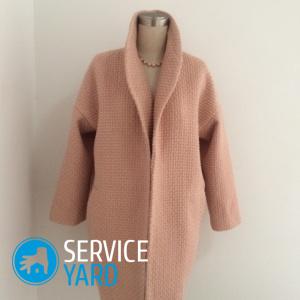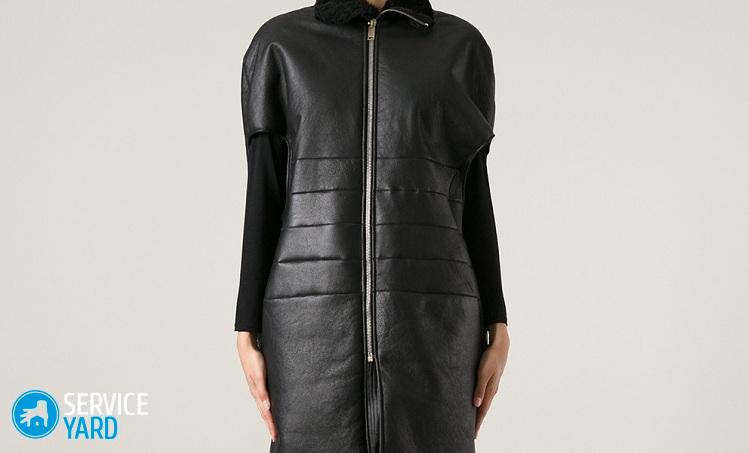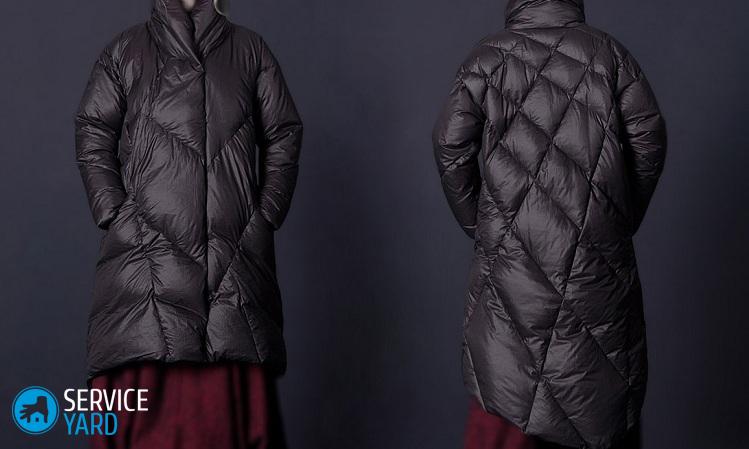DIY cocoon coat pattern

In fashion - freedom, self-expression, and quite naturally - design mistakes. All this is expressed in a style that instantly won the love of many women, because it gives complete freedom of movement and, translated from English, means “very large” or “baggy”. Yes, it's all about the “oversize” style, thanks to which many fashionistas have made an informed choice in favor of clothes that are large in several sizes. She seems to be hanging or borrowed from her boyfriend. This is not a novelty or the know-how of designers, this style came to us from the distant past. And initially this kind of clothing was not called oversize, but a cocoon. Therefore, if you decide to replenish your wardrobe yourself with a new dress or coat in a very loose style, it is best to immediately look for how to make a pattern of a cocoon coat with your own hands. Our article on this topic will help you.
to contents ↑Appearance story
We all know that fashion is cyclical. This is best proved by the coat and down jackets of the cocoon style, which did not find a second, but already a third life. And every time this style was called in a new way:
- The parent of this style can rightfully be called the famous fashion designer Cristobal Balenciaga. Thanks to him, in 1957, the collection, which would now be called oversize, was demonstrated on the catwalk.
- The cocoon model gained frenzied popularity after it was donned by Grace Kelly, at the request of her friend Balenciaga. It was then that tailors first wondered how to sew a cocoon coat and where to get a pattern.
- In the mid-80s of the last century, the style received a new breath from the no less famous fashion designer Yves Saint Laurent. In order to emphasize the Retro style (this is how the clothes made in the cocoon style were presented), the collection was demonstrated in soothing colors and simple silhouettes.
Now in the collection of almost every fashion house or fashion designer there are things in the style of oversize - coats, sweaters, blouses and dresses. And if the prices of such things are unavailable to many, then sew a cocoon coat with your own hands under the strength of each. The main thing is to know all the subtleties and nuances of the cut.
to contents ↑Features of the cocoon style
As we already said, the cocoon immediately became a popular favorite, and there are several explanations for this:
- The contours of the cocoon dress with your own hands are visually blurred, there is no fitting or underlining of a certain part of the body. Therefore, girls with slightly fuller features of the figure such models were to their taste. True, this style is not suitable for ladies-dummies - you run the risk of further increasing your volumes.
- Such clothes are considered universal. The right sweater can be worn safely in the office. By adding accessories to the same outfit, you can go on dates. Cocoon dresses are also acceptable in the office and on vacation.
- A larger sweater looks perfect in combination with a classic shirt. The cuffs and the bottom are as if deliberately sticking out from under the sweatshirt. And layering gives a special zest to the image.
Many people think that to get this style, it’s enough to put on a dress or a cocoon coat several sizes larger with your own hands, and it will look gorgeous. In fact, not everything is so simple. To get a successful pattern, it is worth knowing that this style is created using special technology, when some details, such as the back, collar, sleeves or shelf, are deliberately and reasonably increased:
- The pattern of a cocoon coat with your own hands can be either single-breasted or double-breasted, that is, with and without lining.
- There is no defined standard length for this style. That dress, that coat, can be either very short or long, reaching the middle of the calf.
- Sleeves in this model also depend on the preferences of the hostess. They can be made either excessively wide or very narrow.
Important! The modern fashion industry even offers sleeveless cocoon coats with hand slits, like in capes.
- Do-it-yourself cocoon dress characterizes a flowing silhouette and slightly lowered shoulders.
- Another distinctive feature of cocoon-style clothing is the absence of any decorative elements. Most often, a coat or dress does not have a hood, a collar and pockets.
- And the last nuance that completes the idea of this style is a slightly narrowed bottom of the product, a silhouette, thanks to which the name of the style appeared.
to contents ↑Important! This retro style is set in a modern tone by dense but soft fabrics that were not there a century ago. Cashmere, drape, neoprene, any woolen cloth, and, of course, boucle. It is these textures that make the finished product the most interesting. It is also worth noting that recently quilted models made of water-repellent fabric have appeared on sale. Coats for cold weather began to complement a fur trim to give the cocoon even more chic.
Construction of a pattern of a coat
It’s unlikely that a woman can sew a cocoon coat without a pattern for a woman. This piece of clothing, although it seems simple, has its own nuances that should not be painted directly on the fabric. Often, such models have a one-piece sleeve or dedicated gussets. Therefore, you should first make a pattern of a cocoon coat with your own hands.
And for this you need the following measurements:
- neck volume;
- chest girth;
- hip girth;
- shoulder width;
- the length of the sleeve;
- chest height;
- the length of the front to the waist;
- length of the product.
Given that the pattern of a cocoon coat with your own hands will have one-piece sleeves, you will need one more measurement. The distance from the wrist to the wrist, which is measured through the neck. Then we adhere to the following instructions:
- We build two straight lines that will make a right angle. The vertical line is equal to the length of the product, and the horizontal line is equal to the sum of the lengths. To do this, fold the girth of the neck, shoulder width and sleeve length.
- Then we build auxiliary lines. We lay the chest line from the top of the vertical angle, it should be equal to the height of the chest.
- The waist line also refers to auxiliary lines. It is equal to the length of the front to the waist.
- The hips line is located on the pattern of the cocoon coat with your own hands below the waist line by 20 cm.
- Now we proceed to the construction of the sleeve. From the point where the measure of the length of the shoulder ends, put 4 centimeters vertically down and draw a line that equals the measure of the length of the sleeve.
- At a right angle on the straight line we measure another 10 cm down. If you want a wide sleeve, the distance can be increased to 15 cm.
- Now connect the line of the chest and the bottom line of the sleeve. In the armpit, these lines are rounded.
- We determine what will be the narrowing at the bottom of the product, then continue to draw a line of the sleeve, making a side seam.
It remains only to add allowances for the seams, once again compare the measurements obtained - they should not be less than your original, and you can transfer the details of the pattern of the cocoon coat with your own hands to the fabric.
Important! In order to sew a cocoon coat with your own hands, you will need about 3 meters of the main fabric and about the same amount of lining. Do not forget to buy a non-woven fabric - it will be needed to duplicate the fit, the edges of the product and the collar or neckline.
Useful Tips
Do-it-yourself elements of the cocoon coat pattern, such as pockets, collar, cuffs, are indicated on the pattern in the modeling process. Using these details, you can correctly place accents and create just the perfect look.Also, before you sew a cocoon coat with your own hands, it is worth taking the advice of experienced tailors:
- When tailoring a cocoon coat, you need to consider that in the presence of extra centimeters, it is worth showing some elegant part of the body. For example, you can make cropped sleeves by showing the world narrow and graceful wrists.
- Try to keep your horizontal stitches or stripes away from your hips or abdomen. So you just make your style more overweight.
- Also pay attention to color, because everyone knows that black is slim, as opposed to white.
- Remember that this style is quite original in itself. Therefore, do not embroider almost the entire fabric with rhinestones and beautiful buttons
Constructing a dress pattern
Now we will deal with the issue of creating a cocoon dress and draw a pattern with our own hands. The model, which we take for example, includes such details as:
- shelf - 1 part with a fold;
- back - 1 part with a fold;
- barrel-backlash - 4 parts;
- burlap pocket - 4 parts.
Important! To sew this dress you will need about 2 meters of fabric with a width of 1.5 meters. Give preference to soft flowing fabrics, then the finished cocoon dress with a do-it-yourself pattern will turn out light and not add extra volume.
Here are the main recommendations that it makes sense to follow when creating patterns:
- The shelf of the future dress is cut according to the same principle as the coat. With a deflection at the bottom of the sleeve. But take a little less increase in freedom of fitting.
- The back, as before, is built with a fold according to the same method. Only make the neckline not so deep.
- Details such as barrel clearance and burlap are universal for all dresses. The entrance to the pocket should follow the contours of the side seam. To prevent distortions from the side of the shelf and from the back, make notches at the points of entry into the pocket.
- Remember to add seam allowances. They are standard for all patterns. On the main seams, lay 1 additional centimeter, add 3-4 cm to the hem of the sleeves and the bottom of the product.
To make a cocoon dress with your own hands, fold the fabric with the edges to the middle. On the resulting bends from different sides, place the shelf and back with a “jack” to save material. Circle the neckline with the main parts and do not forget to duplicate them with non-woven fabric.
Helpful hints:
- If your cocoon dress has a high neck with your own hands, then at the stage of drawing up the pattern, measure the total neckline distance along the shelf and on the back. If this distance is less than the circumference of your head, then the back should be done with a zipper, otherwise - you risk not wearing a dress.
- Do not make a zipper on a cocoon dress with your own hands long - 20 cm will be enough to crawl your head.
- If you decide to make a zipper, then the back will not be with a fold, but with a seam, and you will need to lay allowances for this seam - 1 cm on each side.
- First you need to make shoulder seams, then process the pockets, only then connect the sides of the parts.
- First of all, insert the zipper in the back, only then process the neck - so the finished product will look neater.
- After you close the seam on the back, proceed to the processing of the bottom of the sleeve and the dress itself.
What to wear?
After you sewed a cocoon coat with your own hands, a quite relevant question arises: with what to wear this style so as not to look ridiculous? And here, the advice of designers to come to the rescue is always worth considering:
- The model for autumn and winter can be supplemented with a fur collar. It will be ideally combined with both men's shoes and medium-length boots.
- Long gloves will complement the fashionable look. They look very elegant and feminine with a ¾ sleeve.
- If the top is voluminous, then the bottom should be fitted. This golden rule is very suitable for cocoon style. Under such a coat, it is best to wear straight skinny pants or skinny jeans.
- If you sewed a cocoon coat with your own hands and the experiment was a success, then you should replenish your wardrobe with a summer version of such clothes. He will make an excellent set with cropped trousers, skinny jeans and even tight black tights.
Since clothes, in particular a cocoon dress with their own hands, are very similar to a hoodie, you should carefully select accessories for it:
- A long cocoon dress with your own hands will be appropriate to complement with long beads or pendant. The main thing is that the jewelry should be either before or below the waistline. So you can visually break the uniformity of the model.
- Very wide and shortened sleeves will be perfect with wide bracelets and large rings. They emphasize not only the elegance of the style, but also your wrists.
- With a do-it-yourself cocoon dress, tassel earrings that have recently become fashionable and are now in the arsenal of every stylish girl are perfectly combined. Their elongated shape will visually compensate for the excess volume.
- Cardigans - knitted, knitted and even vests, are combined with dresses of a similar style of any length. A very interesting option is obtained when the dress is slightly shorter than the cloak.
to contents ↑Important! A cocoon dress with your own hands does not imply a collar, so it will be successfully combined with a wide variety of scarves, stoles and scarves. You can choose a neck accessory in a contrasting color and wear it as a color accent.
Stock footage
We hope that thanks to our recommendations you can sew a cocoon coat with your own hands or a dress. And complement your wardrobe with a stylish, relevant thing. This coat will warm in cold weather, add originality to your look. A do-it-yourself cocoon dress can become a favorite everyday thing that you don’t want to shoot. The main thing is to remember that the cocoon style does not imply clothes several sizes larger, its individuality lies in the particular cut.
- How to choose a vacuum cleaner taking into account the characteristics of the house and coatings?
- What to look for when choosing a water delivery
- How to quickly create comfort at home - tips for housewives
- How to choose the perfect TV - useful tips
- What to look for when choosing blinds
- What should be running shoes?
- What useful things can you buy in a hardware store
- Iphone 11 pro max review
- Than iPhone is better than Android smartphones






